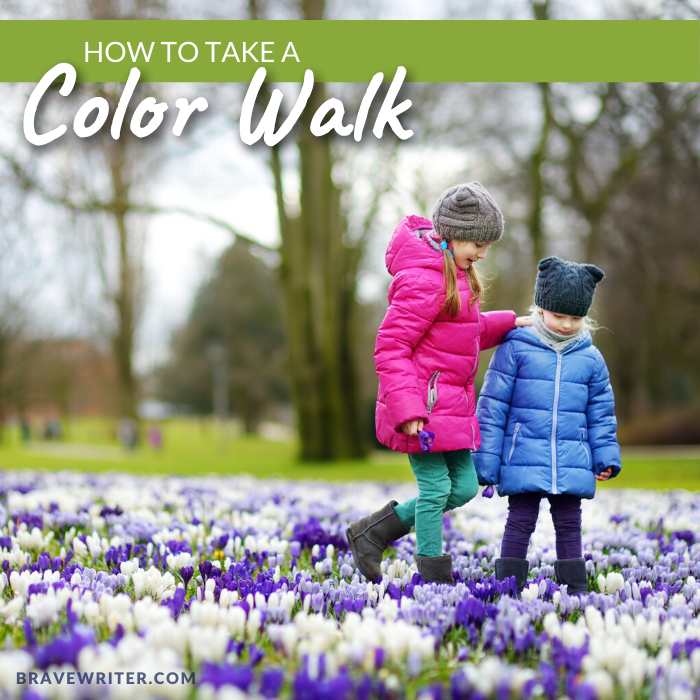
When you take your nature walk this week, you might want to try this exercise with your kids. Be sure to print and read these instructions to your kids (or read them enough yourself that you can share them from memory).
Remember an important Brave Writer principle: If your child is resistant, don’t require participation. Simply enjoy the exercise yourself, and with whichever kids are interested. Live the experience in front of your children and make your own enthusiastic discoveries. Then share them, as your own. Eventually, your kids will catch on and want in on the fun.
This exercise works best if parents and kids both observe a color on the walk and engage in the freewriting that follows.
Also, there is no rule that says each person must have a different color. In order to avoid fights and competition between children, suggest that each child keep his or her color a secret, only to be revealed after the freewriting is done. Then the color choices will be a surprise!
School is not done to children.
The most satisfying learning comes from joyful alertness.
Color Walk
Put on weather appropriate clothing and get ready for a twenty minute walk in your neighborhood. Each person should choose a color before leaving the house. Any color will do. Even if you choose a color not ordinarily viewed at this time of year, you’ll find that it will work with this exercise.
Open the door and go for a walk. Don’t take anything with you (no pens, notepads, clipboards). No talking. Each person quietly observes the front yards, trees, sky, houses, fire hydrants, stop signs, clouds, flowers, creeks, snow and enjoys his or her train of thought without interruption.
If someone blurts or starts to talk, gently put an arm around that child and squeeze him or her to yourself. You can make a quiet “shhh” sound as a reminder. Kiss the child on the head. Stay calm and gentle.
What to notice
As you walk, notice every time you see your color (or don’t see it). Observe what you see. Really look. If you need to stop and look at something for a little while, do that.
Allow your observations to percolate. Make comparisons. Listen to sounds and notice textures and contrasts. Pay attention to the temperature, the color of the sky, the humidity or rain or fog. How cold is it? How warm? Wind or not? Is the sky blue or is it shades of grey and green? Does the grass look different in the shade compared with the full sun? Look at the shapes tree branches make when they intersect against the sky.
When you finish your walk, come home, take off coats. Get a drink of water. Then sit at the table and take out a sheet of paper. Without talking, set the timer for 20 minutes and write about your walk. (If you have younger children, 7-10 minutes will be more than adequate).
Here are a few guidelines for writing about your walk that you want to read before you start writing. Feel FREE in this freewrite. You don’t need to write about the walk necessarily. In other words, you can write about whatever the walk inspires in you.
Freewrite Ideas
- Write an interview with your color.
My oldest son, Noah, picked orange for one of his color walks. We discovered that there is hardly any orange outside. His freewrite evolved into an interview with the color orange wherein we discovered that “orange” is a fairly lonely fellow who feels upstaged by pink and red on a regular basis. - Write a story.
Some of my students in the past end up writing a story that uses the colors in some way. One student created a war between his color (green) and the encroaching fall colors (red, gold and yellow). He gave the colors personalities and they even talked! - Write an allegory.
Find a metaphor that matches how your color operates in the world around you. I wrote about “greedy green” and how it took over the world in summer. - Write about your walk.
You most certainly can chronicle your walk and all the observations you made. You might find that you will naturally expand from the color to a memory or mood or desires and longings. Allow yourself to follow where the color leads. Don’t feel locked into the walk or that it is somehow wrong to just write about what you noticed. Both will work. - What to do if you get stuck.
When you find yourself running out of words, write a sentence that starts like this: Green is like…. or Blue reminds me of…Do that each time you get stuck and follow where it goes. Sometimes when I get stuck, I skip a line and pretend to start over. It frees me from a train of thought that is frustrating. So try that.Or you can suddenly address your writing to someone: an imaginary audience or to yourself or to someone you know. Sometimes focusing on a new audience will help you break out some new words and ideas. Always go back to the walk itself and what you saw, heard, felt.
Nature walks are part of the Brave Writer Lifestyle.

















